Rui Xie
Mitigating Spurious Correlations with Causal Logit Perturbation
May 21, 2025Abstract:Deep learning has seen widespread success in various domains such as science, industry, and society. However, it is acknowledged that certain approaches suffer from non-robustness, relying on spurious correlations for predictions. Addressing these limitations is of paramount importance, necessitating the development of methods that can disentangle spurious correlations. {This study attempts to implement causal models via logit perturbations and introduces a novel Causal Logit Perturbation (CLP) framework to train classifiers with generated causal logit perturbations for individual samples, thereby mitigating the spurious associations between non-causal attributes (i.e., image backgrounds) and classes.} {Our framework employs a} perturbation network to generate sample-wise logit perturbations using a series of training characteristics of samples as inputs. The whole framework is optimized by an online meta-learning-based learning algorithm and leverages human causal knowledge by augmenting metadata in both counterfactual and factual manners. Empirical evaluations on four typical biased learning scenarios, including long-tail learning, noisy label learning, generalized long-tail learning, and subpopulation shift learning, demonstrate that CLP consistently achieves state-of-the-art performance. Moreover, visualization results support the effectiveness of the generated causal perturbations in redirecting model attention towards causal image attributes and dismantling spurious associations.
Continuous Optimization for Feature Selection with Permutation-Invariant Embedding and Policy-Guided Search
May 16, 2025Abstract:Feature selection removes redundant features to enhanc performance and computational efficiency in downstream tasks. Existing works often struggle to capture complex feature interactions and adapt to diverse scenarios. Recent advances in this domain have incorporated generative intelligence to address these drawbacks by uncovering intricate relationships between features. However, two key limitations remain: 1) embedding feature subsets in a continuous space is challenging due to permutation sensitivity, as changes in feature order can introduce biases and weaken the embedding learning process; 2) gradient-based search in the embedding space assumes convexity, which is rarely guaranteed, leading to reduced search effectiveness and suboptimal subsets. To address these limitations, we propose a new framework that can: 1) preserve feature subset knowledge in a continuous embedding space while ensuring permutation invariance; 2) effectively explore the embedding space without relying on strong convex assumptions. For the first objective, we develop an encoder-decoder paradigm to preserve feature selection knowledge into a continuous embedding space. This paradigm captures feature interactions through pairwise relationships within the subset, removing the influence of feature order on the embedding. Moreover, an inducing point mechanism is introduced to accelerate pairwise relationship computations. For the second objective, we employ a policy-based reinforcement learning (RL) approach to guide the exploration of the embedding space. The RL agent effectively navigates the space by balancing multiple objectives. By prioritizing high-potential regions adaptively and eliminating the reliance on convexity assumptions, the RL agent effectively reduces the risk of converging to local optima. Extensive experiments demonstrate the effectiveness, efficiency, robustness and explicitness of our model.
TongUI: Building Generalized GUI Agents by Learning from Multimodal Web Tutorials
Apr 17, 2025Abstract:Building Graphical User Interface (GUI) agents is a promising research direction, which simulates human interaction with computers or mobile phones to perform diverse GUI tasks. However, a major challenge in developing generalized GUI agents is the lack of sufficient trajectory data across various operating systems and applications, mainly due to the high cost of manual annotations. In this paper, we propose the TongUI framework that builds generalized GUI agents by learning from rich multimodal web tutorials. Concretely, we crawl and process online GUI tutorials (such as videos and articles) into GUI agent trajectory data, through which we produce the GUI-Net dataset containing 143K trajectory data across five operating systems and more than 200 applications. We develop the TongUI agent by fine-tuning Qwen2.5-VL-3B/7B models on GUI-Net, which show remarkable performance improvements on commonly used grounding and navigation benchmarks, outperforming baseline agents about 10\% on multiple benchmarks, showing the effectiveness of the GUI-Net dataset and underscoring the significance of our TongUI framework. We will fully open-source the code, the GUI-Net dataset, and the trained models soon.
VGDFR: Diffusion-based Video Generation with Dynamic Latent Frame Rate
Apr 16, 2025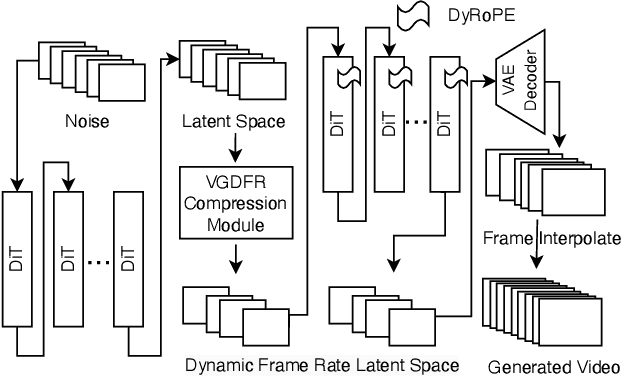
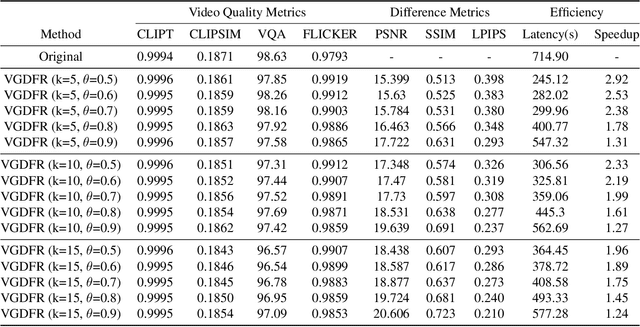

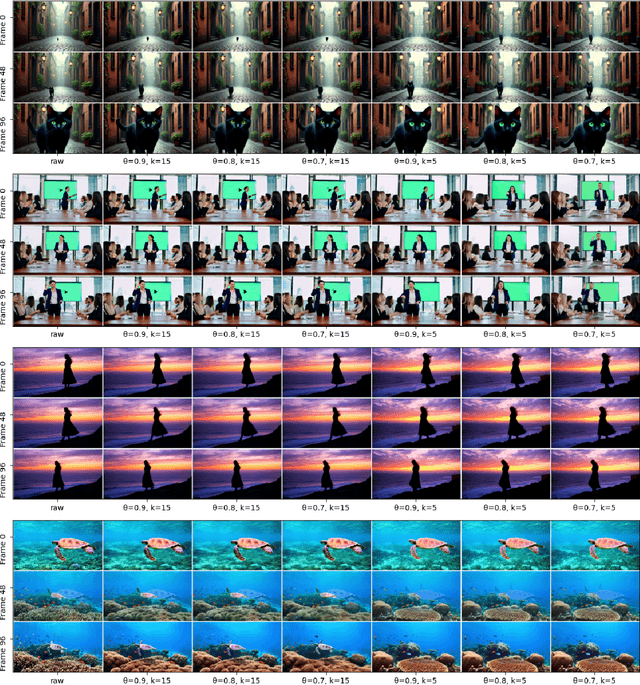
Abstract:Diffusion Transformer(DiT)-based generation models have achieved remarkable success in video generation. However, their inherent computational demands pose significant efficiency challenges. In this paper, we exploit the inherent temporal non-uniformity of real-world videos and observe that videos exhibit dynamic information density, with high-motion segments demanding greater detail preservation than static scenes. Inspired by this temporal non-uniformity, we propose VGDFR, a training-free approach for Diffusion-based Video Generation with Dynamic Latent Frame Rate. VGDFR adaptively adjusts the number of elements in latent space based on the motion frequency of the latent space content, using fewer tokens for low-frequency segments while preserving detail in high-frequency segments. Specifically, our key contributions are: (1) A dynamic frame rate scheduler for DiT video generation that adaptively assigns frame rates for video segments. (2) A novel latent-space frame merging method to align latent representations with their denoised counterparts before merging those redundant in low-resolution space. (3) A preference analysis of Rotary Positional Embeddings (RoPE) across DiT layers, informing a tailored RoPE strategy optimized for semantic and local information capture. Experiments show that VGDFR can achieve a speedup up to 3x for video generation with minimal quality degradation.
DLFR-VAE: Dynamic Latent Frame Rate VAE for Video Generation
Feb 17, 2025
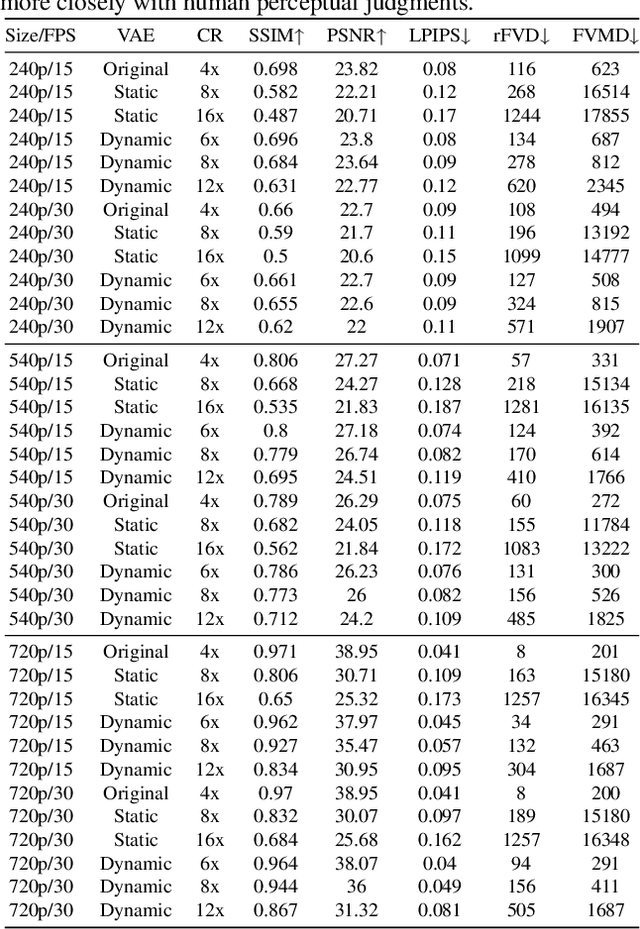
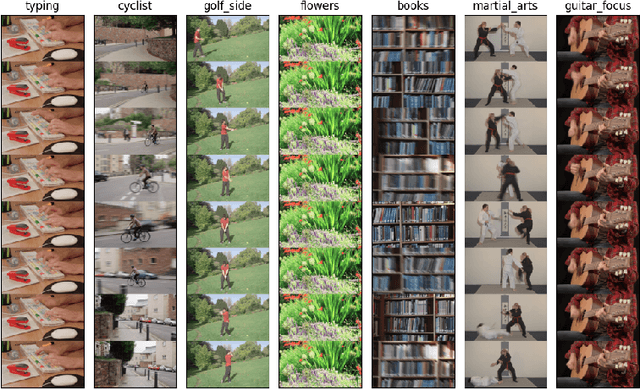
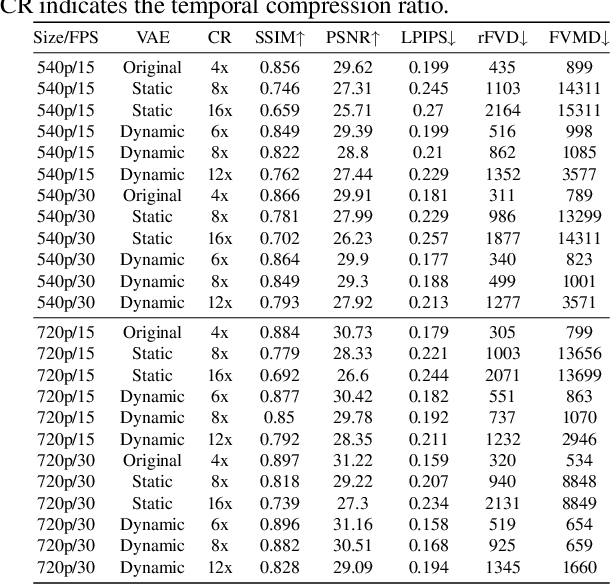
Abstract:In this paper, we propose the Dynamic Latent Frame Rate VAE (DLFR-VAE), a training-free paradigm that can make use of adaptive temporal compression in latent space. While existing video generative models apply fixed compression rates via pretrained VAE, we observe that real-world video content exhibits substantial temporal non-uniformity, with high-motion segments containing more information than static scenes. Based on this insight, DLFR-VAE dynamically adjusts the latent frame rate according to the content complexity. Specifically, DLFR-VAE comprises two core innovations: (1) A Dynamic Latent Frame Rate Scheduler that partitions videos into temporal chunks and adaptively determines optimal frame rates based on information-theoretic content complexity, and (2) A training-free adaptation mechanism that transforms pretrained VAE architectures into a dynamic VAE that can process features with variable frame rates. Our simple but effective DLFR-VAE can function as a plug-and-play module, seamlessly integrating with existing video generation models and accelerating the video generation process.
STAR: Spatial-Temporal Augmentation with Text-to-Video Models for Real-World Video Super-Resolution
Jan 06, 2025Abstract:Image diffusion models have been adapted for real-world video super-resolution to tackle over-smoothing issues in GAN-based methods. However, these models struggle to maintain temporal consistency, as they are trained on static images, limiting their ability to capture temporal dynamics effectively. Integrating text-to-video (T2V) models into video super-resolution for improved temporal modeling is straightforward. However, two key challenges remain: artifacts introduced by complex degradations in real-world scenarios, and compromised fidelity due to the strong generative capacity of powerful T2V models (\textit{e.g.}, CogVideoX-5B). To enhance the spatio-temporal quality of restored videos, we introduce\textbf{~\name} (\textbf{S}patial-\textbf{T}emporal \textbf{A}ugmentation with T2V models for \textbf{R}eal-world video super-resolution), a novel approach that leverages T2V models for real-world video super-resolution, achieving realistic spatial details and robust temporal consistency. Specifically, we introduce a Local Information Enhancement Module (LIEM) before the global attention block to enrich local details and mitigate degradation artifacts. Moreover, we propose a Dynamic Frequency (DF) Loss to reinforce fidelity, guiding the model to focus on different frequency components across diffusion steps. Extensive experiments demonstrate\textbf{~\name}~outperforms state-of-the-art methods on both synthetic and real-world datasets.
E-CAR: Efficient Continuous Autoregressive Image Generation via Multistage Modeling
Dec 19, 2024



Abstract:Recent advances in autoregressive (AR) models with continuous tokens for image generation show promising results by eliminating the need for discrete tokenization. However, these models face efficiency challenges due to their sequential token generation nature and reliance on computationally intensive diffusion-based sampling. We present ECAR (Efficient Continuous Auto-Regressive Image Generation via Multistage Modeling), an approach that addresses these limitations through two intertwined innovations: (1) a stage-wise continuous token generation strategy that reduces computational complexity and provides progressively refined token maps as hierarchical conditions, and (2) a multistage flow-based distribution modeling method that transforms only partial-denoised distributions at each stage comparing to complete denoising in normal diffusion models. Holistically, ECAR operates by generating tokens at increasing resolutions while simultaneously denoising the image at each stage. This design not only reduces token-to-image transformation cost by a factor of the stage number but also enables parallel processing at the token level. Our approach not only enhances computational efficiency but also aligns naturally with image generation principles by operating in continuous token space and following a hierarchical generation process from coarse to fine details. Experimental results demonstrate that ECAR achieves comparable image quality to DiT Peebles & Xie [2023] while requiring 10$\times$ FLOPs reduction and 5$\times$ speedup to generate a 256$\times$256 image.
InstanceCap: Improving Text-to-Video Generation via Instance-aware Structured Caption
Dec 12, 2024



Abstract:Text-to-video generation has evolved rapidly in recent years, delivering remarkable results. Training typically relies on video-caption paired data, which plays a crucial role in enhancing generation performance. However, current video captions often suffer from insufficient details, hallucinations and imprecise motion depiction, affecting the fidelity and consistency of generated videos. In this work, we propose a novel instance-aware structured caption framework, termed InstanceCap, to achieve instance-level and fine-grained video caption for the first time. Based on this scheme, we design an auxiliary models cluster to convert original video into instances to enhance instance fidelity. Video instances are further used to refine dense prompts into structured phrases, achieving concise yet precise descriptions. Furthermore, a 22K InstanceVid dataset is curated for training, and an enhancement pipeline that tailored to InstanceCap structure is proposed for inference. Experimental results demonstrate that our proposed InstanceCap significantly outperform previous models, ensuring high fidelity between captions and videos while reducing hallucinations.
Learnable Infinite Taylor Gaussian for Dynamic View Rendering
Dec 05, 2024



Abstract:Capturing the temporal evolution of Gaussian properties such as position, rotation, and scale is a challenging task due to the vast number of time-varying parameters and the limited photometric data available, which generally results in convergence issues, making it difficult to find an optimal solution. While feeding all inputs into an end-to-end neural network can effectively model complex temporal dynamics, this approach lacks explicit supervision and struggles to generate high-quality transformation fields. On the other hand, using time-conditioned polynomial functions to model Gaussian trajectories and orientations provides a more explicit and interpretable solution, but requires significant handcrafted effort and lacks generalizability across diverse scenes. To overcome these limitations, this paper introduces a novel approach based on a learnable infinite Taylor Formula to model the temporal evolution of Gaussians. This method offers both the flexibility of an implicit network-based approach and the interpretability of explicit polynomial functions, allowing for more robust and generalizable modeling of Gaussian dynamics across various dynamic scenes. Extensive experiments on dynamic novel view rendering tasks are conducted on public datasets, demonstrating that the proposed method achieves state-of-the-art performance in this domain. More information is available on our project page(https://ellisonking.github.io/TaylorGaussian).
LiteVAR: Compressing Visual Autoregressive Modelling with Efficient Attention and Quantization
Nov 26, 2024Abstract:Visual Autoregressive (VAR) has emerged as a promising approach in image generation, offering competitive potential and performance comparable to diffusion-based models. However, current AR-based visual generation models require substantial computational resources, limiting their applicability on resource-constrained devices. To address this issue, we conducted analysis and identified significant redundancy in three dimensions of the VAR model: (1) the attention map, (2) the attention outputs when using classifier free guidance, and (3) the data precision. Correspondingly, we proposed efficient attention mechanism and low-bit quantization method to enhance the efficiency of VAR models while maintaining performance. With negligible performance lost (less than 0.056 FID increase), we could achieve 85.2% reduction in attention computation, 50% reduction in overall memory and 1.5x latency reduction. To ensure deployment feasibility, we developed efficient training-free compression techniques and analyze the deployment feasibility and efficiency gain of each technique.
 Add to Chrome
Add to Chrome Add to Firefox
Add to Firefox Add to Edge
Add to Edge